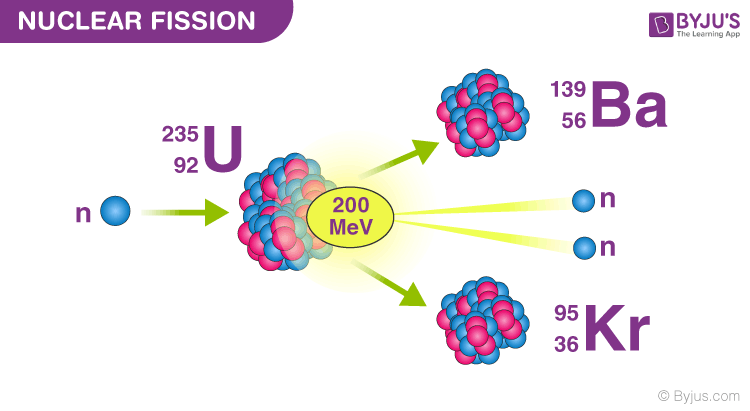Describe the Steps That Occur in the Process of Fission.
In this the organism replicates the genetic material. At this stage in the sequence of events the atom produced is called a fission product to distinguish it from the initial fission fragment formed at scission.

What Is Nuclear Fission Definition Examples Difference Between Fission V S Fusion Nuclear Energy Video And Faqs
Step 1- Replication of DNA.

. Sometimes the prokaryote will carry small plasmids which are small rings of DNA that carry extra genetic information. The fission may be binary fission in which a single organism produces two. Neutron-induced fission can be written as.
Then divides into two parts. The range of fission fragments in air is only a few centimetres. Step 2- Growth of a Cell.
Fission in biology is the division of a single entity into two or more parts and the regeneration of those parts to separate entities resembling the original. When a U-235 nucleus absorbs an extra neutron it quickly breaks into two parts. Nuclei consist of nucleons neutrons and protons the total number of which is equal to the mass number of the nucleus.
Copying of DNA by replication enzymes begins at a spot on the chromosome called the origin of replication. The steps involved in the binary fission in bacteria are. Each time one of these atoms splits or fissions more neutrons are released to split more atoms creating a chain reaction.
The resulting pieces have less combined mass. The chain reaction means if the reaction induces one or more reactions. A growing new cell wall begins to separate the bacterium.
4 The fission of U-236 releases two or three additional neutrons which can be used to cause other fissions and establish a chain reaction. Binary fission steps. The bacterium uncoils and replicates its chromosome essentially doubling its content.
Replication of deoxyribonucleic acid DNA marks the initiation of the binary fission process. The object experiencing fission is usually a cell but the term may also refer to how organisms bodies populations or species split into discrete parts. After copying the chromosome the bacterium starts to grow larger in preparation for binary fissions.
As replication continues the two origins movetowards opposite ends of the cell pulling the rest of the chromosome along with them. The arrangement of particles within uranium-235 is somewhat unstable and the nucleus can disintegrate if it is excited by an outside source. What is the 3rd stage of binary fission.
The origin is the firstpart of the DNA to be copied. During the slowing-down process the charged atom picks up electrons from the medium and becomes neutral by the time it stops. The daughter cells have tightly coiled DNA rods ribosomes and.
When the amoeba cell has reached its maximum size of growththen first the nucleus of amoeba lengthens and divides into two partsAfter that cytoplasm of amoeba divides into two partsone part around each nucleusIn this wayone parent amoeba divides to form smaller amoebaeThe. Is the splitting of a large atomic nucleus into smaller nuclei. Neutrons trigger nuclear fission.
Before binary fission of a prokaryote as seen in step 1 of the above graphic a prokaryote s DNA is tightly wound. During the second step of binary fission the DNA is unraveled. The 2 chromosomes are attached to the cell membrane.
Binary fission is a reproduction Process. In a nuclear reactor a neutron is absorbed into a nucleus typically uranium-235. Most often the masses of the fission fragments are not the same.
The parent organism split or divide to form 2 new organism. Steps of binary fission. The steps involved in binary fission bacterial are -DNA of bacterium uncoils and duplicates.
The actual mass of a nucleus is always less than the sum of the masses of the free neutrons and protons that. The asexual means of reproduction occurs by binary fission. Most of the energy 85 is released in the form of the kinetic energy of the split parts.
This process is common among species like amoeba and bacteria. The complete development of the cell wall results in the split of the bacterium. What is the second stage of binary fission.
In the nucleus of each atom of uranium-235 U-235 are 92 protons and 143 neutrons for a total of 235. The various steps involved in the process of binary fission. Following this a replication bubble is formed which separates the DNA strands.
The fission process may be best understood through a consideration of the structure and stability of nuclear matter. Binary fission is defined as process to divide in half. Fission occurs when an atom is split.
3 The fission of U-236 releases energy in the form of heat which is used to produce high pressure steam and ultimately electricity. N A X FF 1 FF 2 xn where FF 1 and FF 2 are the two daughter nuclei called fission fragments and x is the number of neutrons produced. Nuclear fission is the primary process of generating nuclear energy.
In the first step a uranium-235 atom absorbs a neutron and splits into two new atoms fission fragments releasing three new neutrons and a large amount of binding energy. DNA is pulled to separate poles of the bacterium. The fission process produces free neutrons 2 or 3.
The step-by-step process of binary fission is enlisted below. In the second step one of those neutrons is absorbed by an atom of. To generate heat inside the reactor the operators introduce extra neutrons which cause the uranium atoms to split into smaller atoms.
The process of replicating nucleic acid begins from a replication origin. The missing mass has been converted into nuclear energy. The cell grows and elongates until it is.

Nuclear Fission 7 3 2 Edexcel Igcse Physics Revision Notes 2019 Save My Exams

The Fission Process Mit Nuclear Reactor Laboratory


Comments
Post a Comment